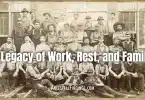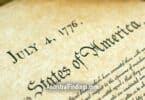Right after the end of the American Revolution, our nation was organized under the Articles of Confederation. This created a loose coalition of states that were essentially independent nations that came together with a weak central government that handled the few affairs that affected every state. Otherwise, states operated pretty much independently.
States could issue their own currency, conduct their own foreign affairs, and could choose to not even send a representative to the national Congress if they chose. It was almost impossible to collect a debt from someone if they lived in a different state, and escaping to another state meant an easy way to start over for fugitives.
Weaknesses in Government Under the Articles of Confederation
Each state’s own laws were superior within its borders to any federal laws that were created. In fact, the few matters that went before the federal government were almost impossible to get passed, as a passing vote required the unanimous consent of all of the states.
There was a unicameral Congress (a separate House and Senate did not exist), presided over by a president who was appointed by Congressional members, but who had no real power other than overseeing sessions of Congress. Interestingly enough, our nation’s first president was technically John Hanson, since he was the first president under the Articles of Confederation. George Washington was the first president under the Constitution that came after it.
An additional weakness of the Articles of Confederation was that funding for the federal government came from the states, and they had no obligation to send money. While the federal government did have the power to tax the states, it had no authority to collect those taxes. Needless to say, this created a very weak system of government, and it wasn’t long before everyone realized a change was needed.
Why There Was Resistance to Changing the Articles
Without revising or abandoning the Articles of Confederation, the new United States (which really weren’t all that united at the time) could easily be taken over by a foreign power, most notably Great Britain, which still had its eye on its former colonies and was looking for an opportunity to step in again as the commanding nation.
Ratified in 1781, the Articles of Confederation were replaced with the Constitution in 1789. This is the Constitution we still use as the basis of our government today. However, the original intent was not to replace the Articles of Confederation entirely.
The people of the United States were suspicious of a strong central government, having been under an unpleasant one when Great Britain was in charge. The convention that was called in 1788 to revise the Articles soon turned into a movement, spearheaded by Alexander Hamilton, to replace them. This convention is now known as the Constitutional Convention because that is where the Constitution was written and eventually ratified by the states in 1789.
During the years under the Articles of Confederation, its weaknesses in running a nation were apparent to everyone. Yet, no one wanted to risk turning over too much power to the federal government. The states had existed as independent colonies with their own cultures for far too long.
Realizing the Need for Change
After a few near disasters, even the most ardent supporter of the Articles had to admit a change was needed.
The most famous incident that caused the realization for the need for change was Shay’s Rebellion, where farmers in Massachusetts rose up against oppressive taxation to fund the expenses of the Revolutionary War, and the federal government was powerless to do anything to quell the uprising. Massachusetts knew then that the Articles weren’t working for them, and other states soon followed.
We enjoy a strong central government under the Constitution today. However, it was not written in a day. A lot of thought and debate went into its contents to ensure the federal government would never have enough power to be oppressive to the people, while still having enough power to run the nation as real, unified one that stood together. While many people have forgotten we had a government before the Constitution, we did, and its failings influenced the changes that gave us the great government we enjoy today.






